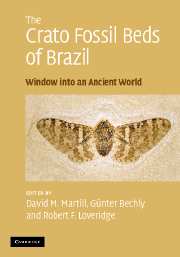Book contents
- Frontmatter
- Contents
- Contributors
- Preface
- Acknowledgements
- Part I The Crato Formation Konservat Lagerstätte
- Part II The invertebrate fauna
- Part III The vertebrate fauna
- Part IV The flora
- 19 The macrophyte flora of the Crato Formation
- 20 Spores and pollen from the Crato Formation: biostratigraphic and palaeoenvironmental implications
- Part V Miscellanea
- Appendix: species list for the Crato Formation
- Systematic index
- Plate section
- References
20 - Spores and pollen from the Crato Formation: biostratigraphic and palaeoenvironmental implications
Published online by Cambridge University Press: 22 August 2009
- Frontmatter
- Contents
- Contributors
- Preface
- Acknowledgements
- Part I The Crato Formation Konservat Lagerstätte
- Part II The invertebrate fauna
- Part III The vertebrate fauna
- Part IV The flora
- 19 The macrophyte flora of the Crato Formation
- 20 Spores and pollen from the Crato Formation: biostratigraphic and palaeoenvironmental implications
- Part V Miscellanea
- Appendix: species list for the Crato Formation
- Systematic index
- Plate section
- References
Summary
Well over 150 spore and pollen taxa have been recorded in the literature from the Crato Formation and other slightly older and younger formations in the Chapada do Araripe, but detailed information on stratigraphic occurrences and relative abundances is mostly lacking. As a result, it is difficult to draw precise biostratigraphic and palaeoenvironmental conclusions, and impossible to recognize any changes in climate and depositional conditions upwards through the succession on the basis of the published record of these plant microfossils. By a process of elimination it is reasonable to suggest an age range of late Aptian to early Albian for the formation from the data presented. It may also be inferred that during the time it accumulated much of the surrounding vegetation was adapted to semi-arid conditions, although there must also have been some habitats that were able to sustain moisture-loving and aquatic plants. The latter is emphasized by the palynological composition of two samples examined specifically for consideration in this chapter, which are unequivocally from the Crato Formation. The assemblages recovered also suggest that the formation is more likely to be late Aptian than early Albian in age. In addition, evidence of reworking of Devonian deposits is apparent. A few of the spores and pollen grains recovered are illustrated (Figure 20.1 and Plate 32).
Background
The great variety and exquisite preservation of insect, fish, plant and other macrofossil remains in the Crato Formation is not obviously matched by similarly abundant and well-preserved palynomorphs (plant microfossils), despite the large number of forms that have been recorded.
- Type
- Chapter
- Information
- The Crato Fossil Beds of BrazilWindow into an Ancient World, pp. 566 - 574Publisher: Cambridge University PressPrint publication year: 2007
References
- 14
- Cited by

